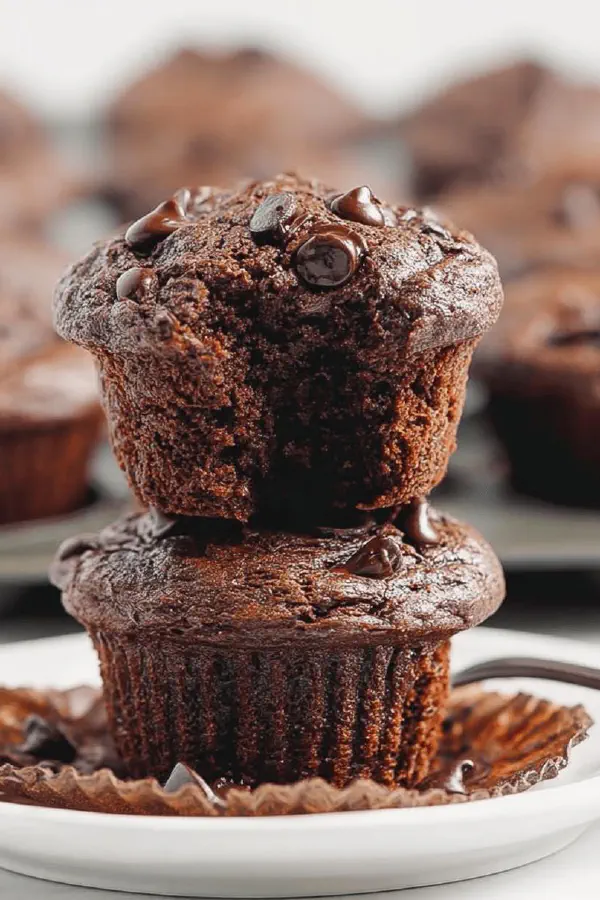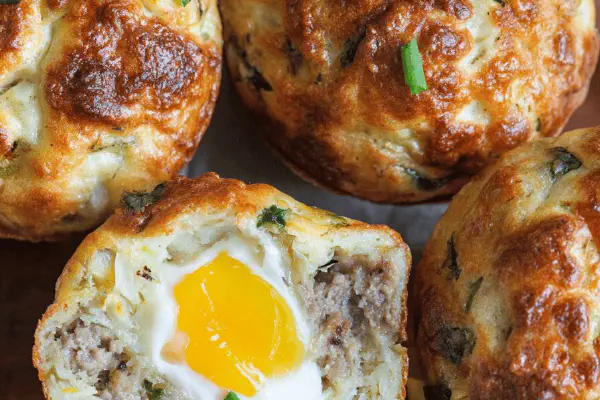Featured Recipe
Dark Cocoa Muffins

By Kate
"
Rich, chocolate-infused muffins packed with dark chocolate chunks. Uses slightly less sugar and replaces butter with oil for moistness. Buttermilk swapped with Greek yogurt. Fluff achieved by folding dry mix gently, avoiding overmixing. Baking powder and baking soda balance acidity. Aroma fills kitchen while baking; crumb moist and tender. Twelve servings, each around 400 calories. Great for breakfast or snack with coffee.
"
Prep:
12 min
Cook:
22 min
Total:
34 min
Serves:
12 servings
muffins
baking
chocolate
snacks
breakfast
Introduction
Not every chocolate muffin needs mountains of butter or sugar. Here, oil steps in—lighter, moister crumb without that heavy feel. Greek yogurt sings in place of some buttermilk, another twist to improve texture and tang. Dark cocoa, not just regular powder, layers depth and a whisper of bitterness. Chunks instead of chips—pockets of molten, uneven, more authentic melt. No chasing perfection—watch, smell, touch muffin tops to know when done. Muffins carry a balance between fluff and structure and learning to read that in your kitchen helps avoid that dense slab you’d otherwise get. A straightforward method, but every step choices help final crumb. Folding, not mixing, critical here; folding preserves air bubbles that give life.
Ingredients
About the ingredients
Flour measurement reduced slightly for less dense crumb. Cocoa powder dark for richer taste—can replace with Dutch-processed for subtle difference but adjust baking soda accordingly. Sea salt preferred for purity but table salt fine if halved. Butter replaced by vegetable oil to cut saturated fat while keeping moisture—neutral oils recommended; olive oil too pungent. Greek yogurt stands in for buttermilk to bring acidity that activates leaveners without thinning batter excessively. Sour cream adds richness but omit if dairy sensitive—extra yogurt can compensate. Chocolate chunks better than chips; they hold shape and offer textural interest. Sugar lowered modestly; adjust to taste, especially if replaced with alternative sweeteners—watch batter moisture changes.
Method
Prepare pan
- Heat oven to 380F. Line muffin tin with liners or grease thoroughly. Oil preferred for even release. Don't skip this.
- Sift together flour, cocoa, salt, baking powder, baking soda, and sugar. Sifting removes lumps, aerates mix for lighter crumb.
- In large bowl, whisk eggs and oil until combined but not frothy. Stir in vanilla, Greek yogurt, and sour cream until smooth. Avoid overbeating.
- Add dry ingredients in one go to wet. Stir gently, fold carefully until barely mixed. Look for patches of flour but no large clumps. Overmix will toughen muffins.
- Fold in chunks carefully to distribute evenly. Avoid smashing pieces. This maintains melty pockets during baking.
- Spoon batter into muffin cups, filling about 75% full to avoid overflow but enough for domed tops.
- Slip into oven. Expect 20 to 25 minutes. Oven variables differ. Watch aroma deepen. Tops should spring back with gentle press, toothpick inserted near center comes out with moist crumbs, not wet batter.
- Rest muffins in pan 7 minutes. Transfer to wire rack to prevent sogginess. Cool fully or warm with butter later.
- Optional: drizzle with melted chocolate or sprinkle toasted nuts for texture contrast.
Dry mix
Wet mix
Combine
Add chocolate
Fill tins
Bake
Cool down
Technique Tips
Higher oven temp (380F) for better rise and browning; muffins might brown on edges—watch carefully. Preparing pan with oil or liners avoids sticking—a pain to rescue muffins otherwise. Sifting dry ingredients removes cocoa lumps and aerates, critical to avoid dense pockets. Mixing order matters: wet before dry achieves even incorporation and prevents gluten overdevelopment; dry added in one batch reduces overhandling. Folding preserves air pockets—stir just enough to combine. Chocolate chunks folded last so pigments don’t overmix into batter. Filling cups three-quarters full avoids dome spill yet enough for height. Baking time varies oven to oven: rely on bounce-back top and moist crumb on toothpick test over exact minutes. Cooling in pan short time softens crust slightly; transferring prevents sogginess from steam. Optional garnishes applied after cooling so chocolate doesn’t melt into warm muffin, maintains texture contrast.
Chef's Notes
- 💡 Sift dry ingredients; lumps can ruin texture. Skip dense muffins. Sift the dry—takes time but worth it. A must for cocoa.
- 💡 Watch baking time—ovens differ wildly. Deeper aroma signals near readiness. Don't just rely on minutes. Press lightly, look for spring back.
- 💡 Oil instead of butter means moistness; less saturated fat. Can use coconut or light olive oil; switch for flavor but mind the outcome.
- 💡 Pay attention when adding dry to wet. Don't overmix. You're folding—keep air pockets. Aim for no large clumps, patches of flour okay.
- 💡 Cool muffins properly. Transfer from pan after 7 minutes; otherwise soggy bottoms happen. Store in airtight for days but no fridge.
Kitchen Wisdom
Why are muffins dense?
Overmixing could be an issue. Gluten develops. Fold gently, only until combined. Avoid large flour patches.
Can I use different flour?
Sure, but results vary. Whole wheat changes texture. Might need more liquid. Experiment with ratios.
What if I run out of sour cream?
Use extra yogurt in its place. Still gets acidity needed. Or milk with a squeeze of lemon.
Storage tips?
Keep in airtight container at room temp. Can freeze for longer storage. Just defrost in fridge, not at room temp.



